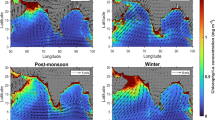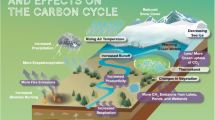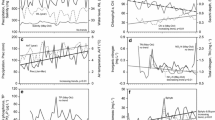Abstract
Water surface greenhouse gas (GHG) emissions in freshwater reservoirs are closely related to limnological processes in the water column. Affected by both reservoir operation and seasonal changes, variations in the hydro-morphological conditions in the river–reservoir continuum will create distinctive patterns in water surface GHG emissions. A one-year field survey was carried out in the Pengxi River–reservoir continuum, a part of the Three Gorges Reservoir (TGR) immediately after the TGR reached its maximum water level. The annual average water surface CO2 and CH4 emissions at the riverine background sampling sites were 6.23 ± 0.93 and 0.025 ± 0.006 mmol h−1 m−2, respectively. The CO2 emissions were higher than those in the downstream reservoirs. The development of phytoplankton controlled the downstream decrease in water surface CO2 emissions. The presence of thermal stratification in the permanent backwater area supported extensive phytoplankton blooms, resulting in a carbon sink during several months of the year. The CH4 emissions were mainly impacted by water temperature and dissolved organic carbon. The greatest water surface CH4 emission was detected in the fluctuating backwater area, likely due to a shallower water column and abundant organic matter. The Pengxi River backwater area did not show significant increase in water surface GHG emissions reported in tropical reservoirs. In evaluating the net GHG emissions by the impoundment of TGR, the net change in the carbon budget and the contribution of nitrogen and phosphorus should be taken into consideration in this eutrophic river–reservoir continuum.









Similar content being viewed by others
References
Abril, G., Guérin, F., Richard, S., Delmas, R., Galy-Lacaux, C., Gosse, P., et al. (2005). Carbon dioxide and methane emissions and the carbon budget of a 10-year old tropical reservoir (Petit Saut, French Guiana). Global Biogeochemical Cycles, 19(4), GB4007. doi:10.1029/2005gb002457.
APHA, W. (1995). AWWA, 1995. Standard methods for the examination of water and wastewater. Washington DC: Amer. Pub. Health Association.
Barros, N., Cole, J. J., Tranvik, L. J., Prairie, Y. T., Bastviken, D., Huszar, V. L. M., et al. (2011). Carbon emission from hydroelectric reservoirs linked to reservoir age and latitude. Nature Geoscience, 4(9), 593–596. doi:10.1038/ngeo1211.
Cabassi, J., Tassi, F., Vaselli, O., Fiebig, J., Nocentini, M., Capecchiacci, F., et al. (2013). Biogeochemical processes involving dissolved CO2 and CH4 at Albano, Averno, and Monticchio meromictic volcanic lakes (Central-Southern Italy). Bulletin of Volcanology, 75(1), doi:10.1007/s00445-012-0683-0.
Chen, H., Wu, Y., Yuan, X., Gao, Y., Wu, N., & Zhu, D. (2009). Methane emissions from newly created marshes in the drawdown area of the Three Gorges Reservoir. Journal of Geophysical Research-Atmospheres, 114, doi:10.1029/2009jd012410.
Chen, H., Yuan, X., Chen, Z., Wu, Y., Liu, X., Zhu, D., et al. (2011). Methane emissions from the surface of the Three Gorges Reservoir. Journal of Geophysical Research-Atmospheres, 116, doi:10.1029/2011jd016244.
Cole, J. J., Prairie, Y. T., Caraco, N. F., McDowell, W. H., Tranvik, L. J., Striegl, R. G., et al. (2007). Plumbing the global carbon cycle: integrating inland waters into the terrestrial carbon budget. Ecosystems, 10(1), 171–184. doi:10.1007/s10021-006-9013-8.
Delmas, R., Galy-Lacaux, C., & Richard, S. (2001). Emissions of greenhouse gases from the tropical hydroelectric reservoir of Petit Saut (French Guiana) compared with emissions from thermal alternatives. Global Biogeochemical Cycles, 15(4), 993–1003. doi:10.1029/2000gb001330.
DelSontro, T., Kunz, M. J., Kempter, T., Wueest, A., Wehrli, B., & Senn, D. B. (2011). Spatial heterogeneity of methane ebullition in a large tropical reservoir. Environmental Science & Technology, 45(23), 9866–9873. doi:10.1021/es2005545.
dos Santos, M. A., Matvienko, B., Rosa, L. P., dos Santos, E. O., Sikar, E., Rocha, C. H. E. D. A., et al. (2006). Preliminary results of carbon budget in two hydroelectric reservoirs in Brazil (Dams and reservoirs, societies and environment in the 21st century, Vols 1 and 2).
Duchemin, E., Lucotte, M., & Canuel, R. (1999). Comparison of static chamber and thin boundary layer equation methods for measuring greenhouse gas emissions from large water bodies. Environmental Science & Technology, 33(2), 350–357. doi:10.1021/es9800840.
Fearnside, P. M. (1995). Hydroelectric dams in the Brazilian Amazon as sources of greenhouse gases. Environmental Conservation, 22(1), 7–19.
Fearnside, P. M. (1997). Greenhouse-gas emissions from Amazonian hydroelectric reservoirs: the example of Brazil's Tucurui Dam as compared to fossil fuel alternatives. Environmental Conservation, 24(1), 64–75. doi:10.1017/s0376892997000118.
Fearnside, P. M. (2014). Impacts of Brazil's Madeira River Dams: unlearned lessons for hydroelectric development in Amazonia. Environmental Science & Policy, 38, 164–172. doi:10.1016/j.envsci.2013.11.004.
Finlay, J. C. (2003). Controls of streamwater dissolved inorganic carbon dynamics in a forested watershed. Biogeochemistry, 62(3), 231–252.
GalyLacaux, C., Jambert, C., Delmas, R., Dumestre, J. F., Labroue, L., Cerdan, P., et al. (1996). Methane emission and oxygen consumption in the hydroelectric dam of Petit-Saut in French Guyana. Comptes Rendus De L Academie Des Sciences Serie Ii Fascicule a-Sciences De La Terre Et Des Planetes, 322(12), 1013–1019.
Goldenfum, J. A. (2010). GHG measurement guidelines for freshwater reservoir. The UNESCO/IHA greenhouse gas emission from freshwater reservoirs research project. 2010: 10–18.
Grimard, Y., & Jones, H. (1982). Trophic upsurge in new reservoirs: a model for total phosphorus concentrations. Canadian Journal of Fisheries and Aquatic Sciences, 39(11), 1473–1483.
Gross, M. F., Hardisky, M. A., Wolf, P. L., & Klemas, V. (1993). Relationships among Typha biomass, pore water methane, and reflectance in a Delaware (USA) brackish marsh. Journal of Coastal Research, 9(2), 339–355.
Guerin, F., & Abril, G. (2007). Significance of pelagic aerobic methane oxidation in the methane and carbon budget of a tropical reservoir. Journal of Geophysical Research-Biogeosciences, 112(G3), doi:10.1029/2006jg000393.
Hertwich, E. G. (2013). Addressing biogenic greenhouse gas emissions from hydropower in LCA. Environmental Science & Technology, 47(17), 9604–9611. doi:10.1021/es401820p.
Holbach, A., Wang, L., Chen, H., Hu, W., Schleicher, N., Zheng, B., et al. (2013). Water mass interaction in the confluence zone of the Daning River and the Yangtze River—a driving force for algal growth in the Three Gorges Reservoir. Environmental Science and Pollution Research, 20(10), 7027–7037. doi:10.1007/s11356-012-1373-3.
Huttunen, J. T., Vaisanen, T. S., Hellsten, S. K., & Martikainen, P. J. (2006). Methane fluxes at the sediment–water interface in some boreal lakes and reservoirs. Boreal Environment Research, 11(1), 27–34.
IPCC (2014). Climate Change 2014: Synthesis report. In I. a. I. t. t. F. A. R. o. t. I. P. o. C. C. C. W. T. Contribution of working groups I, R.K. Pachauri and L.A. Meyer (eds.)] (Ed.), (pp. 151 pp). IPCC, Geneva.
Itoh, M., Kobayashi, Y., Chen, T.-Y., Tokida, T., Fukui, M., Kojima, H., et al. (2015). Effect of interannual variation in winter vertical mixing on CH4 dynamics in a subtropical reservoir. Journal of Geophysical Research-Biogeosciences, 120(7), 1246–1261. doi:10.1002/2015jg002972.
Jähne, B., & Haußecker, H. (1998). Air–water gas exchange. Annual Review of Fluid Mechanics, 30(1), 443–468.
Jähne, B., Münnich, K. O., Bösinger, R., Dutzi, A., Huber, W., & Libner, P. (1987). On the parameters influencing air–water gas exchange. Journal of Geophysical Research: Oceans (1978–2012), 92(C2), 1937–1949.
Kumar, A., Schei, T., Ahenkorah, A., Rodriguez, R. C., Devernay, J.-M., Freitas, M., et al. (2011). Hydropower. In O. Edenhofer, R. Pichs-Madruga, Y. Sokona, K. Seyboth, P. Matschoss, S. Kadner, et al. (Eds.), IPCC special report on renewable energy sources and climate change mitigation. Cambridge: Cambridge University Press.
Morana, C., Borges, A. V., Roland, F. A. E., Darchambeau, F., Descy, J. P., & Bouillon, S. (2015a). Methanotrophy within the water column of a large meromictic tropical lake (Lake Kivu, East Africa). Biogeosciences, 12(7), 2077–2088. doi:10.5194/bg-12-2077-2015.
Morana, C., Darchambeau, F., Roland, F. A. E., Borges, A. V., Muvundja, F., Kelemen, Z., et al. (2015b). Biogeochemistry of a large and deep tropical lake (Lake Kivu, East Africa: insights from a stable isotope study covering an annual cycle). Biogeosciences, 12(16), 4953–4963. doi:10.5194/bg-12-4953-2015.
Newbold, J. D., Mulholland, P. J., Elwood, J. W., & O'Neill, R. V. (1982). Organic carbon spiralling in stream ecosystems. Oikos, 38, 266–272.
Ostrofsky, M., & Duthie, H. (1980). Trophic upsurge and the relationship between phytoplankton biomass and productivity in Smallwood Reservoir, Canada. Canadian Journal of Botany, 58(10), 1174–1180.
Pacheco, F. S., Soares, M. C. S., Assireu, A. T., Curtarelli, M. P., Roland, F., Abril, G., et al. (2015). The effects of river inflow and retention time on the spatial heterogeneity of chlorophyll and water–air CO2 fluxes in a tropical hydropower reservoir. Biogeosciences, 12(1), 147–162. doi:10.5194/bg-12-147-2015.
Ramos, F. M., Bambace, L. A. W., Lima, I. B. T., Rosa, R. R., Mazzi, E. A., & Fearnside, P. M. (2009). Methane stocks in tropical hydropower reservoirs as a potential energy source. Climatic Change, 93(1–2), 1–13. doi:10.1007/s10584-008-9542-6.
Rosa, L. P., Dos Santos, M. A., Matvienko, B., Sikar, E., & Dos Santos, E. O. (2006). Scientific errors in the Fearnside comments on greenhouse gas emissions (GHG) from hydroelectric dams and response to his political claiming. Climatic Change, 75(1–2), 91–102. doi:10.1007/s10584-005-9046-6.
Rosa, L. P., & Schaeffer, R. (1995). Global warming potentials—the case of emissions from dams. Energy Policy, 23(2), 149–158. doi:10.1016/0301-4215(95)91418-c.
Soumis, N., Duchemin, E., Canuel, R., & Lucotte, M. (2004). Greenhouse gas emissions from reservoirs of the western United States. Global Biogeochemical Cycles, 18(3), doi:10.1029/2003gb002197.
St Louis, V. L., Kelly, C. A., Duchemin, E., Rudd, J. W. M., & Rosenberg, D. M. (2000). Reservoir surfaces as sources of greenhouse gases to the atmosphere: a global estimate. Bioscience, 50(9), 766–775. doi:10.1641/0006-3568(2000)050[0766:rsasog]2.0.co;2.
Teodoru, C. R., Bastien, J., Bonneville, M.-C., del Giorgio, P. A., Demarty, M., Garneau, M., et al. (2012). The net carbon footprint of a newly created boreal hydroelectric reservoir. Global Biogeochemical Cycles, 26, doi:10.1029/2011gb004187.
Teodoru, C. R., Prairie, Y. T., & del Giorgio, P. A. (2011). Spatial heterogeneity of surface CO2 fluxes in a newly created Eastmain-1 reservoir in northern Quebec, Canada. Ecosystems, 14(1), 28–46. doi:10.1007/s10021-010-9393-7.
Yang, L., Lu, F., Wang, X., Duan, X., Song, W., Sun, B., et al. (2013). Spatial and seasonal variability of diffusive methane emissions from the Three Gorges Reservoir. Journal of Geophysical Research-Biogeosciences, 118(2), 471–481. doi:10.1002/jgrg.20049.
Zeng, H., Song, L., Yu, Z., & Chen, H. (2006). Distribution of phytoplankton in the Three-Gorge Reservoir during rainy and dry seasons. Science of the Total Environment, 367(2–3), 999–1009. doi:10.1016/j.scitotenv.2006.03.001.
Zhao, Y., Wu, B. F., & Zeng, Y. (2013). Spatial and temporal patterns of greenhouse gas emissions from Three Gorges Reservoir of China. Biogeosciences, 10(2), 1219–1230. doi:10.5194/bg-10-1219-2013.
Zhu, K., Bi, Y., & Hu, Z. (2013). Responses of phytoplankton functional groups to the hydrologic regime in the Daning River, a tributary of Three Gorges Reservoir, China. Science of the Total Environment, 450, 169–177. doi:10.1016/j.scitotenv.2013.01.101.
Acknowledgements
This study was supported by the National Natural Science Foundation (Nos. 51679226 and 41601537) and the National Science and Technology Major Project on Water Pollution Control and Management (2014ZX07104-006 and 2015ZX07103-007). The China Three Gorges Corporation provided financial support as well. Dr. Lindsey Yasarer was supported by the NSF EAPSI Award # IIA-1414818. We also thank Tao Jiang, Lei Bai, Lin Wang, Chen Zhang, Jing Liu, Zengyu Zhang, etc., who participated in field sampling and lab analysis. All the data in the manuscript are accessible and could be requested from the corresponding author whose email address is Lizhe@cigit.ac.cn.
Author information
Authors and Affiliations
Corresponding author
Rights and permissions
About this article
Cite this article
Huang, Y., Yasarer, L.M.W., Li, Z. et al. Air–water CO2 and CH4 fluxes along a river–reservoir continuum: Case study in the Pengxi River, a tributary of the Yangtze River in the Three Gorges Reservoir, China. Environ Monit Assess 189, 223 (2017). https://doi.org/10.1007/s10661-017-5926-2
Received:
Accepted:
Published:
DOI: https://doi.org/10.1007/s10661-017-5926-2




